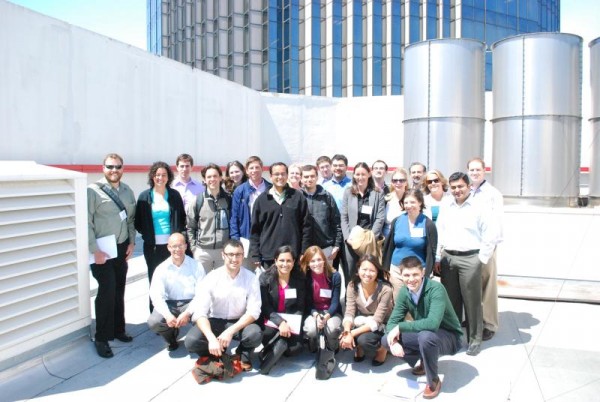 Climate Corps. Photo: Environmental Defense FundBack in May I wrote about the Environmental Defense Fund’s (EDF) Climate Corps, a cadre of 26 MBA students who were then prepping for summer internships at Fortune 500 companies. Their mission was to green up corporate operations to save money and cut carbon emissions.
Climate Corps. Photo: Environmental Defense FundBack in May I wrote about the Environmental Defense Fund’s (EDF) Climate Corps, a cadre of 26 MBA students who were then prepping for summer internships at Fortune 500 companies. Their mission was to green up corporate operations to save money and cut carbon emissions.
With winter on the way and school back in session, I checked in to see how successful the Climate Corps was at combining the students’ financial smarts, technological know-how — half are engineers by training — and environmental ethic.
Pretty successful, it turns out. According to EDF, the interns identified energy efficiency measures that will collectively save an estimated $54 million at 22 companies (and one university), including eBay, Dell and Sony Pictures Entertainment. That translates into 100,000 metric tons of greenhouse gases avoided a year with an annual energy savings of 160 million kilowatt hours.
A couple of caveats are in order. Energy efficiency programs were already under way at many of the companies. And whether the projected $54 million in savings will actually be realized won’t be known until the energy efficiency efforts are completed — actual results may vary.
Still, anything close to $54 million is quite a return on investment, given that the companies altogether spent only $260,000 on intern salaries during the 10-week program.
But the long-term payoff is likely to be the emergence of a new corporate class- – the green financial engineer — and future CEOs — who reflexively view environmental performance as a bottom-line concern.
“Many of these companies have people working on energy efficiency but it really helps to have another set of eyes on the ground,” says Millie Chu Baird, the Climate Corps project director. “Even if a company thinks it’s doing everything it can, we found often it can be doing more.”
That was networking giant Cisco’s experience. Last year, Climate Corps intern Emily Reyna made the business case for installing intelligent power strips in the company’s labs to reduce electricity consumption. That will save an estimated $8 million annually with an 18-month payback period.
This year, intern Sarah Shapiro helped implement the power strip project while spearheading an initiative to cut power use by raising the ambient air temperature in the labs and in the chilled water that cools equipment. Projected savings? $1.8 million a year.
A Cisco manager had done a back-of-the-envelope analysis of such a project’s potential, but it was Shapiro’s job to gather the data to make the financial case for such an initiative.
“I spent a lot of time banging on doors and hanging out in data center to get the data,” says Shapiro, who is pursuing dual degrees from the University of Michigan business school and its school of natural resources.
“Day to day there was a lot of talking to relevant people at Cisco, a lot of energy managers, human resources and workplace management,” she added. “I worked a lot with energy folks to provide financial perspective on initiatives they were already working on.”
And that’s the missing link in a lot of corporate energy efficiency programs, according to Rob Rolfsen, who oversees Cisco facilities as director of workplace resources.
“Labs represent two-thirds of our carbon footprint,” says Rolfsen. “Sarah brought a business side approach and could work with the engineers to develop a business case for what we wanted to do.”
Shapiro’s classmate, Ryan Whisnant, found that being a liaison between the gear heads and the number crunchers allowed him to exert influence in subtle ways. Posted to SunGard, a $5.5 billion software and IT services company headquartered outside Philadelphia, Whisnant went for a meet-and-greet with a facility manager and mentioned the lack of energy efficient compact fluorescent light bulbs in the building’s lobby.
“The next time I came back I saw that CFLs were in the lobby,” says Whisnant. “I found out that after our meeting the facility manager called and said to switch out the bulbs.”
Whisnant spent most of his time developing energy efficiency measures for SunGard’s corporate headquarters, such as retrofitting lighting, heating, and cooling systems.
“We built a whole financial model on a project-by-project basis in terms of lighting retrofits and to optimize building management systems,” he says.
And it’s not just forward-looking Silicon Valley-type tech companies that have embraced the Climate Corps. Among those cashing in on the interns’ expertise: TXU, the coal-dependent utility once the bête noir of the environmental movement, supermarket chain Stop and Shop/Giant and even the NBA basketball team, the Houston Rockets.


